Immigrant assimilation in Denmark
A brief overview of the school performance of 1st, 2nd and 3rd generation immigrants in Denmark
In this short piece I take a brief look at the school performance of immigrants in Denmark and, in particular, how much assimilation and improvement occurs over time.
Assimilation within 1st generation
I recently found an interesting visualization of school performance of refugees in Denmark (Hassan et al., 2023). Upon arrival, they lag much further behind in Danish than in Mathematics — understandable, given their unfamiliarity with the language.
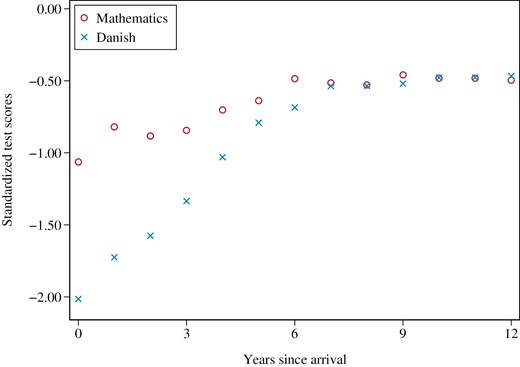
Slowly they improve in both subjects, but especially in Danish. After 7 years, the refugees have reached a steady state where the gaps do not differ by subject, and overall gaps do not diminish with further time. At this point, the refugees are approximately half a standard deviation behind the national average (and a little more behind Danish natives).
Assimilation from 1st to 2nd generation
The descendants of immigrants (second-generation immigrants) also have better outcomes than their parents. It would be shocking if they did not, given that immigrants’ children grow up with Danish as native tongue and in Danish schools—an advantage they did not themselves enjoy.
The average grades of immigrants and their descendants is provided by Statistics Denmark.1 I have illustrated boys’ grades in the figure below.2
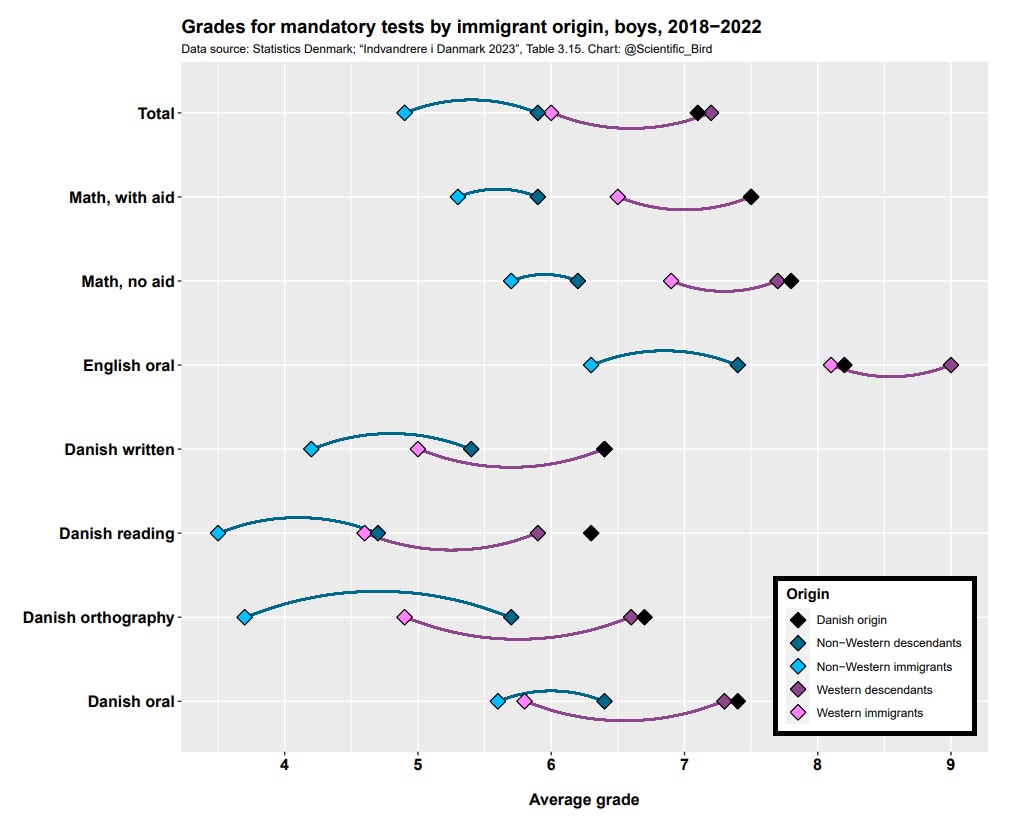
We can also illustrate the average grades when considered relative to the Danish origin level. That is shown below.
A few things are noteworthy. First, there is a clear assimilation effect from first to second generation. As expected, descendants score substantially higher than immigrants in all tests. Also not surprising, the gap between immigrants and descendants is largest for Danish and smallest for mathematics. Second, Western descendants and native Danes have very similar grade point averages. Third, even in second generation, non-Westerners lag substantially behind natives and Western descendants.
Assimilation from 2nd to 3rd generation
While it is intuitively obvious that there would be substantial assimilation from 1st to 2nd generation, some also believe that substantial improvements should happen with each subsequent generation. But, given that both 2nd and 3rd generation immigrants equally had the advantage of learning Danish as a native language and attending Danish schools, it is not obvious that this would be the case. This question has also received much less research. Luckily, Statistics Denmark published these data as well, which can be seen below.
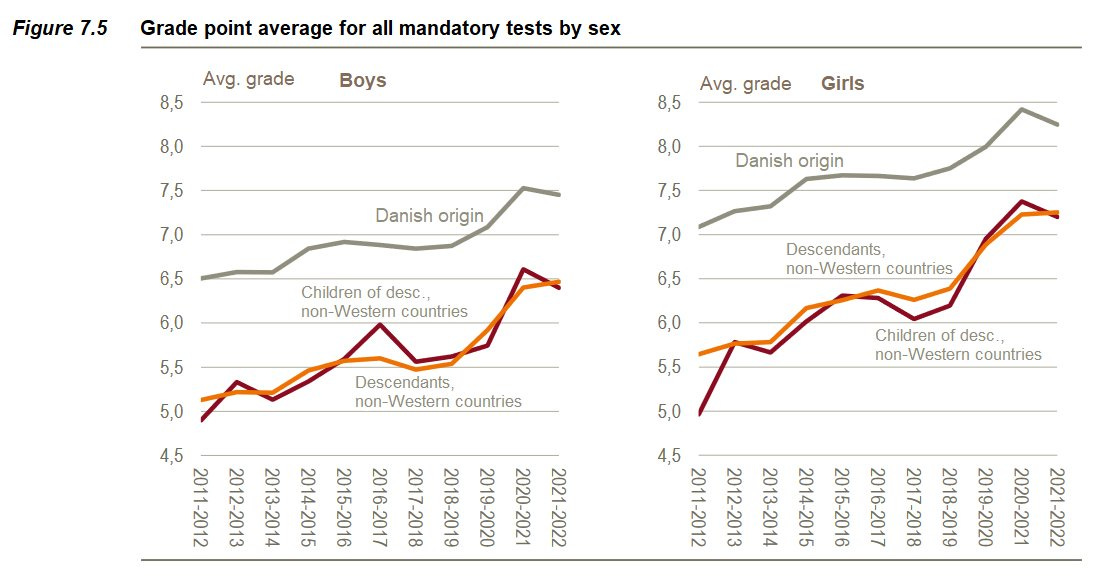
The red and orange lines lie solidly on top of each other, meaning that 3rd generation immigrants have no measurable advantage over 2nd generation immigrants. This is evidence against the idea that major further assimilation occurs in each generation beyond the second.3 Though one potential confounder to keep in mind is that the national origin compositions may differ meaningfully between the two generations. So it’s possible that a small change is masked by confounding.
Why do non-Westerners lag behind?
In Denmark, descendants of Western immigrants have (on average) very similar school performance as Danish natives. It is only descendants of non-Western immigrants who lag substantially behind. Why is this?
In fact, this is not particular to Denmark. It is empirically well-established that immigrant student performance is, in general, strongly related to origin population performance, and this persists across generations (De Philippis & Rossi, 2020; Carabaña, 2011). The source of the differences is ultimately extant human capital differences between countries, which transmit intergenerationally.
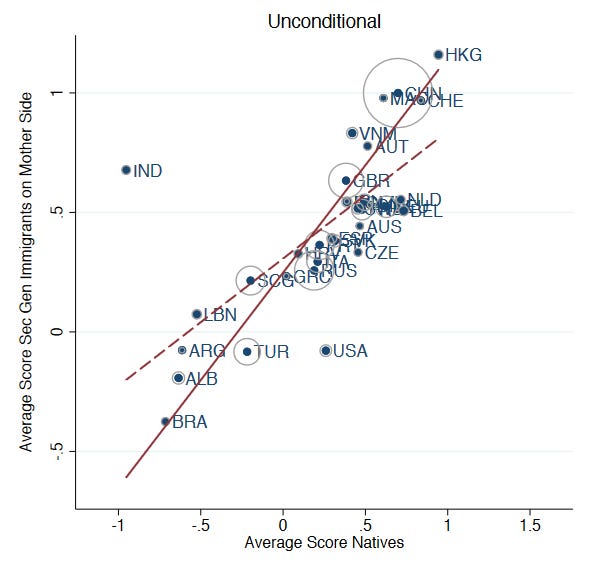
Where large differences exist between origin populations and their emigrants (e.g., India), it is usually indicative of strong immigration selectivity (van de Werfhorst & Heath, 2019; Cattaneo & Wolter, 2015).
Conclusion
In terms of immigrant school performance, there is a clear assimilation effect from first to second generation. This is unsurprising given that second-generation immigrants grow up with the native tongue and attend native schools.
It appears, however, that substantial assimilation does not occur for subsequent generations. On average, non-Western second-generation immigrants have lower educational achievement than Danish natives, and this remains equally true for third-generation immigrants.
Statistics Denmark, “Indvandrere i Danmark 2023”, Table 3.15.
The overall picture doesn’t change much for girls’ grades, except it’s shifted upward a bit because girls achieve higher average grades.
Some have pointed out that the the gap has become smaller over the years, from 1.5 to 1 grade point over a decade. That is, narrowing over time, not necessarily between generations. But we cannot interpret the numbers as a narrowing in educational achievement. As is clear in the graph, there has been substantial grade inflation over the period, so a 1 grade point difference cannot be assumed to mean the same in 2022 as in 2012. It is mathematically expected that groups further from the ceiling will experience this grade inflation effect more, so not much can be interpreted from this score narrowing. The fact that it isn’t observed between the generations should also give some pause to that interpretation.


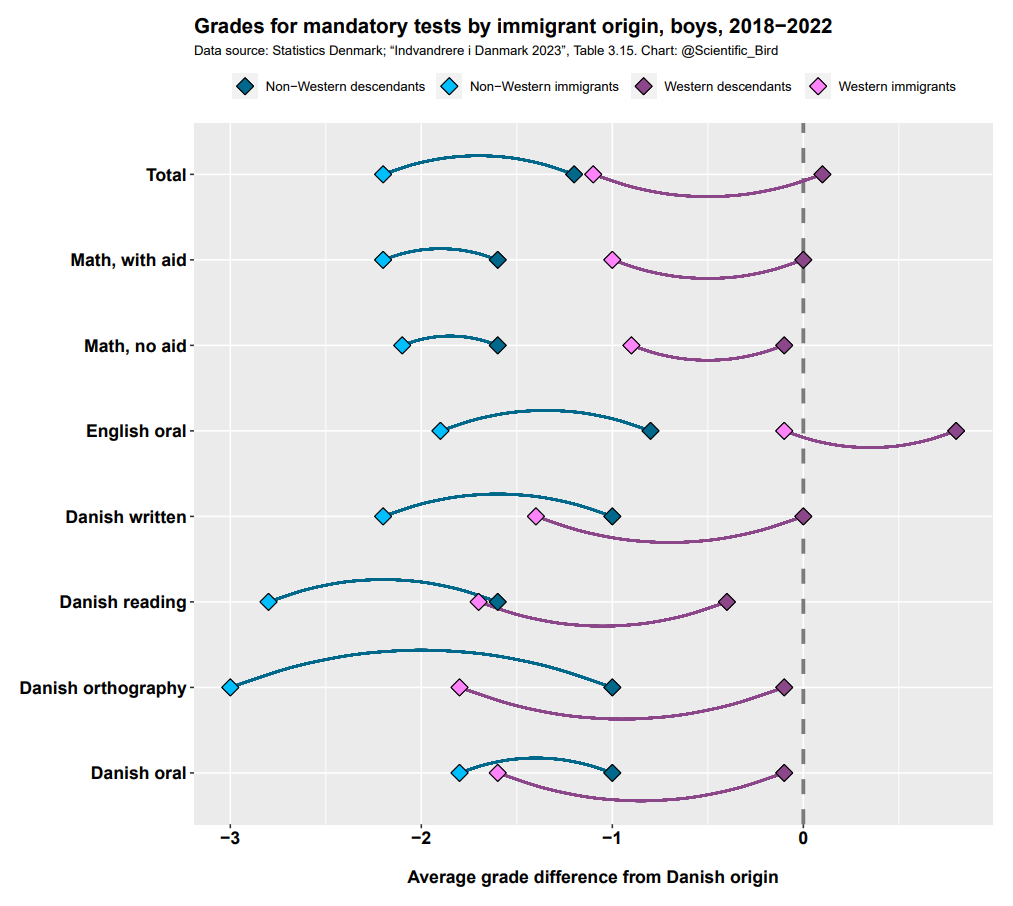
Thank you. It's almost like there is some sort of limitation in certain groups to achieve at levels comparable to other groups...
Why am I not surprised? If the immigrants (non-Western) “assimilating” are not equal in innate ability, then they will never rise to the level of native Danes. We have this problem here in the USA wrt even our native stock—much less the millions pouring in from the third world annually.
Here it is forbidden socially/politically to ascribe differences in outcomes between the races/ethnicities to be caused by anything other than environment, hence a decades old (fruitless) pursuit to bring one race up the the level of another—the usual marker being that of native Whites (mostly of European stock). Failure to achieve this lofty goal is attributed to racism on the part of the majority population.
So now we are in the midst of a movement to simply ignore ability and promote those underachieving minorities regardless of merit or ability. This process (Affirmative Action via quotas) has the effect of “balancing the numbers”, but also the negative effect of placing incompetence in positions of power such that their incompetence has grievous effects on the society. A once first world nation is now in decline, but as yet refuses to recognize such.
The Danes would be wise to learn from us before they destroy their society through immigration of citizens from third world countries. There is a reason they are from the third world and Danes are from the first world.